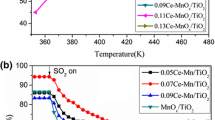Abstract
An earlier sample of 5% CoO x /TiO2 used for the wet oxidation of TCE at 310 K forca. 6 h has been characterized with a fresh catalystvia XRD and XPS measurements. The binding energy for Co 2p3/2 of the fresh sample appeared at 781.3 eV, which was very similar to the chemical states of CoTiO x such as Co2TiO4 and CoTiO3, whereas the spent catalyst indicated a 780.3-eV main peak for Co 2p3/2 with a satellite structure at a higher energy region. This binding energy was almost equal to that of Co3O4 among reference Co compounds used. The phase structure of Co3O4 was revealed upon XRD measurements for all the catalyst samples. Based on these XPS and XRD results, a surface chemical structure of CoO x species existing with the fresh catalyst can be proposed to be predominantly Co3O4 encapsulated completely by very thin filmlike CoTiO x consisting of Co2TiO4 and/or CoTiO3, with a tiny amount of Co3O4 particles covered partially by such cobalt titanates which may be responsible to the initial catalytic activity. Those CoTiO x overlayers on Co3O4 particles may be readily removed into the wet media within 1 h at 310 K based on our earlier study, thereby giving rapid increase in the catalytic activity for that period.
Similar content being viewed by others
References
Brik, Y., Kacimi, M., Ziyad, M. and Bozon-Verduraz, F., “Titania-Supported Cobalt and Cobalt-Phosphorus Catalysts: Characterization and Performances in Ethane Oxidative Dehydrogenation”,J. Catal.,202, 118 (2001).
Chuang, T. J., Brundle, C. R. and Rice, D. W., “Interpretation of the X-ray Photoemission Spectra of Cobalt Oxides and Cobalt Oxide Surfaces”,Surf. Sci.,59, 413 (1976).
Drago, R. S., Jurczyk, K., Singh, D. J. and Young, V., “Low-Temperature Deep Oxidation of Hydrocarbons by Metal Oxides Supported on Carbonaceous Materials”,Appl. Catal. B,6, 155 (1995).
Frydman, A., Castner, D. G., Schmal, M. and Campbell, C. T., “Particle and Phase Thicknesses from XPS Analysis of Supported Bimetallic Catalysts: Calcined Co-Rh/Nb2O5”,J. Catal.,152, 164 (1995).
Haumodi, S., Larachi, R. and Sayari, A., “Wet Oxidation of Phenolic Solutions over Heterogeneous Catalysts: Degradation Profile and Catalyst Behavior”,J. Catal.,177, 247 (1998).
Ho, S. W., Cruz, J. M., Houalla, M. and Hercules, D. M., “The Structure and Activity of Titania Supported Cobalt Catalysts”,J. Catal.,135, 173 (1992).
Hocevar, S., Batista, J. and Levec, J., “Wet Oxidation of Phenol on Ce1-x-CuxO2-d Catalyst”,J. Catal.,184, 39 (1999).
Hosokawa, S., Kanai, H., Utani, K., Taniguchi, Y. I., Saiti, Y. and Imamura, S., “State of Ru on CeO2 and Its Catalytic Activity in the Wet Oxidation of Acetic Acid”,Appl. Catal. B,45, 181 (1998).
Kim, M. H. and Choo, K. H., “Catalytic Wet Oxidation of TCE over Supported Metal Oxides”,Theor. Appl. Chem. Eng.,9, 1180 (2004).
Kim, M. H., Ebner, J. R., Friedman, R. M. and Vannice, M. A., “Determination of Metal Dispersion and Surface Composition in Supported Cu-Pt Catalysts”,J. Catal.,208, 381 (2002).
Kim, J. H. and Lee, H. I., “Effect of Surface Hydroxyl Groups of Pure TiO2 and Modified TiO2 on the Photocatalytic Oxidation of Aqueous Cyanide”,Korean J. Chem. Eng.,21, 116 (2004).
Kim, M. J., Nam, W. and Han, G.Y., “Photocatalytic Oxidation of Ethyl Alcohol in an Annulus Fluidized Bed Reactor”,Korean J. Chem. Eng.,21, 721 (2004).
Kim, M. H., Nam, I. S. and Kim, Y.G., “Characteristics of Mordenite-Type Zeolite Catalysts Deactivated by SO2 for the Reduction ofNO with Hydrocarbons”,J. Catal.,179, 350 (1998).
Krishnamoorthy, S., Rivas, J. A. and Amirdis, M. D., “Catalytic Oxidation of 1,2-Dichlorobenzene over Supported Transition Metal Oxides”,J. Catal.,193, 264 (2000).
Larachi, F., Iliuta, I. and Belkacemi, K., “Catalytic Wet Air Oxidation with a Deactivating Catalyst Analysis of Fixed and Sparged Three-Phase Reactors”,Catal. Today,64, 309 (2001).
Lee, G., Rho, S. and Jahng, D., “Design Considerations for Groundwater Remediation using Reduced Metals”,Korean J. Chem. Eng.,21, 621 (2004).
Pintar, A., “Catalytic Processes for the Purification of Drinking Water and Industrial Effluents”,Catal. Today,77, 451 (2003).
Pintar, A. and Levec, J., “Catalytic Oxidation of Organics in Aqueous Solutions: I. Kinetics of Phenol Oxidation”,J. Catal.,135, 345 (1992).
Sadana, A. and Katzer, J. R., “Involvement of Free Radicals in the Aqueous-Phase Catalytic Oxidation of Phenol over Copper Oxide”,J. Catal.,35, 140 (1974).
Sexton, B. A., Hughes, A. E. and Turney, T. W., “An XPS and TPR Study of the Reduction of Promoted Cobalt-Kieselguhr Fischer-Tropsch Catalysts”,J. Catal.,97, 390 (1986).
Sidebottom, H. and Franklin, J., “The Atmospheric Fate and Impact of Hydrochlorofluorocarbons and Chlorinated Solvents”,Pure Appl. Chem.,68, 1757 (1996).
Silva, A. M. T., Marques, R. R. N. and Quinta-Ferreira, R. M., “Catalysts Based in Cerium Oxide for Wet Oxidation of Acrylic Acid in the Prevention of EnvironmentalRisks”,Appl. Catal. B,47, 269 (2004).
Thormahlen, P., Skoglundh, M., Fridell, E. and Andersson, B., “Low-Temperature CO Oxidation over Platinum and Cobalt Oxide Catalysts”,J. Catal.,188, 300 (1999).
Venezia, A. M., “X-ray Photoelectron Spectroscopy (XPS) for Catalysts Characterization”,Catal. Today,77, 359 (2003).
VoΒ, M., Borgmann, D. and Wedler, G., “Characterization of Alumina, Silica, and Titania Supported Cobalt Catalysts”,J. Catal.,212, 10 (2002).
Yankin, A., Vikhreva, O. and Balakirev, V., “P-T-x Diagram of the Co-Ti-O System”,J. Phys. Chem. Solids,60, 139 (1999).
Yao, Y. F. Y., “The Oxidation of Hydrocarbons and CO over Metal Oxides: III. Co3O4”,J. Catal.,33, 108 (1974).
Author information
Authors and Affiliations
Corresponding author
Rights and permissions
About this article
Cite this article
Kim, M.H. Surface chemical structures of CoO x /TiO2 catalysts for continuous wet trichloroethylene oxidation. Korean J. Chem. Eng. 22, 839–843 (2005). https://doi.org/10.1007/BF02705662
Received:
Accepted:
Issue Date:
DOI: https://doi.org/10.1007/BF02705662




